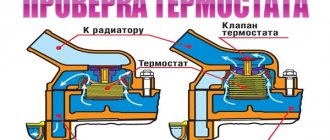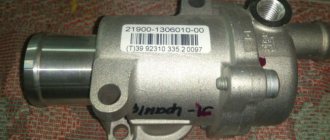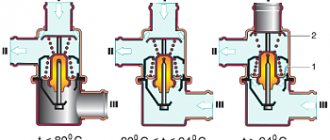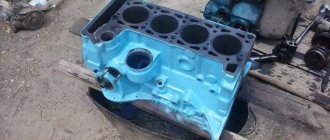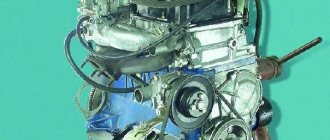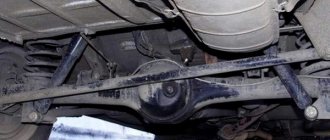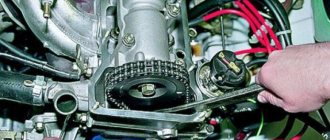The VAZ 2106 thermostat is a device whose main task is to control the normal temperature regime of the internal combustion engine. Used with a liquid cooling system. When the engine is cold, the engine cooling liquid does not circulate through the heat removal lines. When the engine reaches 95 °C, the thermostat allows coolant to circulate. Thanks to this temperature regulator, the car's power plant warms up much faster, which allows you to extend the service life of parts of the crank and gas distribution mechanisms, as well as elements of the cylinder-piston group.
Purpose of the thermostat on the VAZ 2106
The thermostat must control the degree of heating of the coolant and react in a timely manner when the antifreeze temperature becomes too high or, conversely, too low.
The thermostat maintains the temperature of the coolant in the engine cooling system in the desired range
The device can direct coolant through either a small or large cooling circle, thereby preventing the engine from overheating, or, conversely, helping it quickly warm up after a long period of inactivity. All this makes the thermostat the most important element of the VAZ 2106 cooling system.
Thermostat location
The thermostat in the VAZ 2106 is located to the right of the engine, where the pipes for discharging coolant from the main radiator are located. To see the thermostat, simply open the hood of the car. The convenient location of this part is a big plus when it becomes necessary to replace it.
To gain access to the VAZ 2106 thermostat, simply open the hood
Principle of operation
As mentioned above, the main task of the thermostat is to maintain the engine temperature within specified limits. When the engine needs to warm up, the thermostat blocks the main radiator until the engine reaches the optimal temperature. This simple measure can significantly extend the life of the engine and reduce wear on its components. The thermostat has a master valve. When the coolant reaches a temperature of 70 °C, the valve opens (it should be noted here that the opening temperature of the main valve can be higher - up to 90 °C, and this depends both on the design of the thermostat and on the thermal filler that is in it used).
Essentially, a thermostat is a regular valve that responds to changes in antifreeze temperature
The second important element of the thermostat is a special compression cylinder made of brass, inside of which there is a small piece of technical wax. When the antifreeze in the system reaches 80 °C, the wax in the cylinder melts. As it expands, it presses on the long rod connected to the main thermostat valve. The rod extends from the cylinder and opens the valve. And when the antifreeze cools, the wax in the cylinder begins to harden, and its expansion coefficient decreases. As a result, the pressure on the rod weakens and the thermostatic valve closes.
By opening the valve here we mean moving its leaf by only 0.1 mm. This is the initial opening value, which consistently increases by 0.1 mm as the antifreeze temperature rises by two to three degrees. When the coolant temperature rises by 20 °C, the thermostat valve opens fully. The full opening temperature can vary from 90 to 102 °C depending on the manufacturer and design of the thermostat.
- Thermostat for VAZ 2115 - device, replacement and repair
Replacing the thermostat Lada 2131 (VAZ 2131)
Usually, if the thermostat malfunctions on a Niva, and indeed on all other cars, it is not repaired, but completely replaced. This procedure itself is simple, but first you will need to completely drain the coolant. Since the Niva and “classic” engines are the same, you can read about draining the antifreeze here: replacing antifreeze on a VAZ 2107. After the coolant has been drained from the engine and radiator, we can proceed further and here we only need one Phillips screwdriver or holder with a suitable size bat:
You will need to unscrew the bolts securing the clamps that securely connect the pipes and terminals of the Niva thermostat. In total you will have to unscrew three bolts, which are clearly visible below in the picture:
After this, we disconnect the pipes one by one from the thermostat outlets, which is clearly shown in the photo below:
After this, we buy a new thermostat, the price of which for a Niva is about 300 rubles, and install it in the reverse order.
Also, it is worth keeping in mind that before putting on the pipes, they must be wiped dry, and if necessary, replace the clamps with new ones. If, after installation, it turns out that antifreeze or antifreeze is oozing at some connection points, then the surest way would be to replace the required pipe with a new one!
The problem of thermostat failure on a VAZ 2121 Niva is quite common. Its breakdown is characterized by such symptoms as constant overheating of the engine or, conversely, the coolant temperature does not reach the operating temperature, but remains at 60-70 degrees. To replace the Niva thermostat, you only need a Phillips screwdriver of the required diameter.
After which you can begin the removal procedure by unscrewing with a Phillips screwdriver all the bolts of the clamps on the pipes that are connected to the thermostat:
Then, when all the clamps are loosened to the required level, remove the pipes one by one with your hands using medium force, as is clearly shown in the photo below:
And the last step will be to remove this part from the engine compartment. This is what it looks like after removal from the car:
We replace this device in the reverse order. The price of a new one is approximately 300 rubles, so you won’t have to spend much. Good luck with the repair to you and your Niva!
Removing the thermostat on a VAZ 2121 and Niva 2131 is done to replace or repair it. The thermostat is an all-metal housing with a built-in valve that opens/closes depending on the temperature of the liquid in the system. When the engine is not warmed up, the valve is closed accordingly, that is, the liquid flows through a small cooling circle, as a result of which the system warms up faster. When the temperature reaches operating mode, the thermostat valve opens and liquid begins to circulate through the radiator, that is, in a large circle.
Characteristic signs indicating a malfunction to the driver: the warm-up time has increased, which means that most likely the valve does not close and the liquid circulates all the time in a large circle, or, on the contrary, the engine overheats as a result of incomplete opening of the valve and the circulation of the main volume of liquid in a small circle. Also, after the engine reaches operating temperature, check the supply pipe to the radiator; if it is cold in relation to the system, then the thermostat is closed.
To carry out repair work, prepare a standard set of tools, drain the cooling system and perform the following sequence of actions:
- When removing the thermostat, residual liquid may get onto the generator; to prevent this, cover it with a plastic bag.
- Using a Phillips screwdriver, loosen the clamps securing the pipes and remove it. We make a replacement, after which we carry out the installation in the reverse order.
At this point, the repair work on removing and installing the thermostat on the VAZ 2121 and Niva 2131 has been completed.
Types of thermostats
The VAZ 2106 car was produced for many years. And during this time, engineers made a number of changes to it, including thermostats. Let's look at what thermostats were installed on the VAZ 2106 from the release of the first cars to the present day.
Single valve thermostat
Single-valve thermostats were installed on the very first “sixes” that rolled off the VAZ assembly line. The operating principle of this device has been described in detail above. To date, these devices are considered obsolete, and finding them on sale is not so easy.
The first “sixes” were equipped with the simplest, single-valve thermostats
Electronic thermostat
An electronic thermostat is the latest and most advanced modification that replaced single-valve devices. Its main advantages are high accuracy and reliability. Electronic thermostats have two operating modes: automatic and manual.
Electronic thermostats are used in modern cooling systems and differ from their predecessors in high accuracy and much greater reliability
Liquid thermostat
Thermostats are classified not only by design, but also by the type of fillers. Liquid thermostats were the very first to appear. The main component of a liquid thermostat is a small brass cylinder filled with distilled water and alcohol. The operating principle of this device is the same as that of the wax-filled thermostats discussed above.
Solid thermostat
The filler in such thermostats is ceresin. This is a substance similar in consistency to regular wax, which is mixed with copper powder and placed in a copper container. The cylinder has a rubber membrane connected to a rod, also made of dense rubber that is resistant to high temperatures. Ceresin, expanded from heating, presses on the membrane, which, in turn, acts on the rod and valve, ensuring the circulation of antifreeze.
The main element of a solid-fill thermostat is a container with ceresite and copper powder
Which thermostat is better
Today, thermostats based on solid fillers are considered the best option for the VAZ 2106, since they have the optimal combination of price and quality. In addition, they can be found in any auto store, unlike liquid single-valve ones, which are practically no longer on sale.
- Thermostat VAZ 2112 16 valves
Radiator and thermostat
It remains to deal with the last things in this system - the radiator and thermostat. Because with the arrival of cold weather, the car does not want to warm up. It does not gain more than 75 degrees while moving.
This car has changed a lot of thermostats, many of them have not been driven before leaving the garages for the city. During 16 years of driving and 250 thousand, my father changed 1 thermostat, which I foolishly threw out and lost. And since then this problem of underheating has tormented me constantly. In winter, always with cardboard, but what about in winter - I had to set it at +10.
Lately there has been a return, which I had high hopes for. Return TH 3720.80
I installed it in the spring, but at +10 the engine is already underheating even with the heater half turned on.
But is this where the working thermostats end? I started trying to find others.
That’s right, in the winter I drove the seven with him. There is a shutter on the valve like on the original Soviet thermostats. The car warmed up quickly and stayed at 80 in the winter. But alas, it slipped right away, and such a thermostat can no longer be found. The store counter is full of Chinese crap from well-known companies. Alas, over the years the situation does not get better... but to bring something suitable takes more than 10 days, or is completely refused.
I accidentally found a thermostat from 1997, brass, heavy, not Soviet, of course, but a complete copy.
It still seems to work, and there's barely a hiss of air when you try to blow it out. You can bet, but there is no particular desire. Nobody knows how long he has left to work, and he’s already beaten from the sides.
For almost 2.5 years I lay in the garage in a pile of junk, a new expensive metal-incar thermostat, and all because the sensor on the tidy deceived me, it overestimated the temperature, so when it became 95, I probed the thermostat, made sure that it did not open, although it did not should have, and Well I didn't throw it in the trash.
In short, I installed it. It doesn’t seem to be a fake, as long as it works and holds the temperature, it heats up quickly. The problem is that now you can’t bring one like this - a fake arrives with clear marks (on the original, I read, they are blurred - the same with me) and with a golden body inside painted with a thin layer, mine is galvanized white, and in powder. There is a curtain, and it is made of plastic
This is how I check thermostats.
Of course, I boiled it on the stove, but it took a long time. All the same, they work differently on the engine, but at least it will be clear whether they open or not. I also found such a thermostat, WEEN 182-0014, although it came to me in an aluminum case, but on the autopilot they wrote that it was plastic.
I haven't installed or tested it yet. It cost 400 rubles, it was somehow painfully cheap...
There was a Luzar-Sport radiator, and it still is. But, thinking that it was too powerful for this engine, I decided to buy the “original”. And they slipped me a dirty trick. The worst thing is that I was a fool and painted it so that it wouldn’t be visible from behind the bars. And then I realized that there were no mararoni turbulizers inside. Briefly speaking. So the sports radiator remained on the car. Cools very quickly. When the pressure gauge was in the upper pipe, a little wind blew towards the radiator, and the pressure immediately dropped to 0.
Daaz - OAT, why are there no turbulators inside? Or is it too expensive to install them? Like the bar on top of the radiator? Even the luzar has it...
I bought brt pipes and freshened them up, so to speak. And get rid of the pressure gauge, who remembers. So far he has completed his task on this machine, I hope it will last for a long time.
In short, the result is the following. the cap will return, the radiator is a luzar sport (by the way, here again is a kick in the direction of luzar - the radiator is excellent, strong, the tanks are hard, but could they be compressed normally? We had to re-crimp the tanks, they were leaking. And this was at a pressure of less than 0.5 bar, when the cap was fluff , it was still in winter.) Mounting the fan sensor, could it be improved? So that the mortgage does not turn inside? For this price that I paid, I have the right to demand it! In general, they seem to have been discontinued. To be honest, it’s a bit of a pity, it still looks more impressive than the snot original...
Luzar heater tap, well, you can’t find a normal tap anymore? But there are none! To be fair, knock on wood, it’s been standing since 2022. Not leaking yet. I use it regularly. But my brother’s new faucet on his car, the same one started flowing down the stem right away. This year I installed it. The thermostat is metal-incar, it also lives for now. But how can I buy another one without any problems? They bring only fakes...
Source
Signs of a broken thermostat
There are a number of signs that clearly indicate that the thermostat is faulty:
- The light on the instrument panel is constantly on, indicating that the engine is overheating. This usually happens because the thermostat valve has closed and is stuck in that position;
- The engine warms up very poorly. This means that the thermostat valve does not close tightly. As a result, antifreeze flows through both the small and large cooling circles and cannot warm up in a timely manner;
- After the engine starts, the lower thermostat tube heats up literally within a minute. You can check this by simply placing your hand on the nozzle. This situation indicates that the thermostat valve is stuck in the fully open position.
If any of these symptoms are detected, the driver should replace the thermostat as soon as possible. If the car owner ignores the above symptoms, this will inevitably lead to overheating of the engine and its jamming. It is extremely difficult to restore an engine after such a breakdown.
What signs of malfunction occur?
This device can get stuck in both the open and closed states, as well as in one of the middle states. Therefore, cooling malfunction can be of two types,
- The engine will overheat and the antifreeze will boil if the valve is closed and the liquid does not enter the radiator. Then, at least for some time, turning on the stove at full heat and maximum airflow can help. Naturally, this option is the most dangerous.
- The engine will take much longer to warm up if the valve is “stuck” open. This is still better than the first option, but the thermostat still needs to be replaced.
Methods for checking the thermostat
There are four main ways to test the thermostat's functionality. We list them in increasing order of complexity:
- The engine starts and idles for ten minutes. After this, you need to open the hood and carefully touch the lower hose coming out of the thermostat. If the device is working correctly, the temperature of the lower hose will not differ from the temperature of the upper one. After ten minutes of operation they will be warm. And if the temperature of one of the hoses is significantly higher, the thermostat is broken and needs to be replaced.
- The engine starts and idles. After starting the engine, you need to immediately open the hood and put your hand on the hose through which antifreeze enters the upper part of the radiator. If the thermostat is working properly, this hose will be cold until the engine is properly warmed up. If the thermostat is working properly, then immediately after starting the engine, the hose leading to the radiator will remain cold, and when the engine is fully warmed up, it will become hot
- Check in liquid. This method involves removing the thermostat from the car and submerging it in a pan of hot water and a thermometer. As mentioned above, the temperature at which the thermostat fully opens varies from 90 to 102 °C. Therefore, it is necessary to immerse the thermostat in water when the thermometer shows a temperature within these limits. If after diving the valve instantly opens, and after removal from the water it gradually closes, then the thermostat is working. If not, you need to change it. To check the operation of the thermostat, you only need a pan of water and a thermometer
- Check using the ICH-10 hour indicator. The previous testing method only allows you to establish the very fact of opening and closing the valve, but does not make it possible to accurately determine the temperature at which all this happens. In order to measure it, you need a clock indicator, which is installed on the thermostat rod. The thermostat itself is immersed in a container with cold water and a thermometer (the thermometer division should be 0.1 °C). Then the water in the pan begins to heat up. This can be done either using a boiler or by putting the entire structure on gas. As the water heats up, the degree of valve opening is monitored and recorded and displayed on a dial indicator. The observed numbers are then compared with the stated thermostat specifications, which can be found in the vehicle's owner's manual. If the difference in numbers does not exceed 5%, the thermostat is working; if not, it needs to be replaced. Checking with a dial indicator gives greater accuracy compared to the method that uses a conventional thermometer
Video: checking the thermostat
Malfunctions and testing of the VAZ-2107 thermostat
- does not open at all or opens partially - leads to engine overheating;
- does not close - the engine heats up slowly after a cold start, the engine does not reach operating temperature.
To find out the functionality of the thermostat, you should check at what temperature its main valve begins to open, as well as the stroke of this unit. Since the thermostat itself is mounted in a non-separable housing, this can only be done accurately using special equipment (for example, the BS-106.000 stand).
The simplest check of the VAZ-2107 thermostat can be performed directly on the car by touch.
In the case of a working thermostat, after starting a cold engine, the lower radiator tank should not heat up immediately, but when the arrow on the coolant temperature gauge is 3–4 mm from the red scale zone, which corresponds to 80–85 °C.
If the radiator starts to heat up immediately, this means that the thermostat is not closing. If it’s later, its valve gets stuck. An overheating engine can be evidence of insufficient valve travel when it does not open completely. In all cases, the thermostat must be replaced.
We independently change the thermostat on a VAZ 2106
Before starting work, you should select tools and consumables. To replace the thermostat we will need:
- new thermostat;
- coolant (5 liters);
- basin for draining old antifreeze;
- flat screwdriver.
It should be noted here that the thermostat cannot be repaired. The reason is simple: inside it has a thermoelement with liquid or solid filler. It is the one that fails most often. But such elements are not sold separately, so the car owner has only one option - replacing the entire thermostat.
Sequence of work
Before performing any manipulations with the thermostat, you need to drain the coolant. Without this operation, further work is impossible. It is convenient to drain antifreeze by placing the car on an inspection hole and unscrewing the cap of the main radiator.
- After draining the antifreeze, the car hood opens. The thermostat is located to the right of the engine. Three hoses fit to it. All hoses from the thermostat must be removed
- The hoses are attached to the thermostat pipes using steel clamps, which are loosened using a flat-head screwdriver. It is most convenient to loosen the clamps on the thermostat hoses with a large flat-head screwdriver
- After loosening the clamps, the hoses are removed from the pipes manually, the old thermostat is removed and replaced with a new one. The hoses are returned to their place, the clamps are tightened, and new coolant is poured into the radiator. The thermostat replacement procedure can be considered complete. After removing the hoses, the VAZ 2106 thermostat is removed manually
Video: changing the thermostat yourself
So, the owner of a VAZ 2106 does not need to go to the nearest car service center to replace the thermostat. Everything can be done with your own hands. This task is entirely within the capabilities of a novice driver who has at least once held a screwdriver in his hands. The main thing is not to forget to drain the antifreeze before starting work.
Replacement procedure
Before changing the thermostat on a VAZ 2114, watch the video tutorials. making it easy to master a rather complex procedure with your own hands. You certainly can’t call a DIY replacement impossible. However, it won't hurt to gain additional knowledge.
Also prepare the necessary tools and materials:
- New thermostat;
- Screwdriver Set;
- Keys for 13 and 12 millimeters;
- Sealing gasket;
- Silicone based sealant;
- New antifreeze or antifreeze;
- Container for old coolant;
- Engine cooling system pipes.
Now let's get down to the repair itself.
- Place the car on the inspection pit. Before starting work, the engine must cool down, otherwise burns will be difficult to avoid.
- Open the hood and remove the air filter. Check its condition. It might be a good idea to replace it.
- Remove the expansion tank cap, unscrew the drain plug and remove all the antifreeze. Make sure it fits exactly into the container underneath.
- There are clamps on the cooling hoses that need to be loosened a little.
- Using wrenches, remove the nuts and studs responsible for fastening. Be sure to remove the ground wire.
- After you disconnect the hoses, wiggle the thermostat a little to allow it to be removed.
- Clean the thermostat mounting points and check the hoses for serviceability. Often during the life of the car they become covered with cracks, through which air and coolant escape. Even if they are intact, but have been on the car for a long time, we recommend replacing them with new ones.
- Treat the pipes on the body of the new thermostat with sealant and let them dry a little.
- Replace the old gasket, put the thermostat in place, fix the studs, nuts, and connect the pipes. The clamps must be tightened well, but carefully so as not to break the tightness of the connections.
- Close the drain plug, and then you can start adding new coolant.
- Start the engine and check the efficiency of your new thermostat valve.
- Make sure that the heating radiator is in good working order and check for any air pockets.
Before changing the thermostat on a VAZ 2114, watch video tutorials that will make it easy to master a rather complex procedure with your own hands. You certainly can’t call a DIY replacement impossible. However, it won't hurt to gain additional knowledge.
Thermostat VAZ 2106
An element of a vehicle’s liquid cooling system, such as a thermostat, is a device with which the vast majority of passenger cars are equipped. It is located in the engine compartment in the space around the engine in the pipeline network between the power plant and the radiator. Externally, it is a sealed cylinder made of light alloy materials with holes, to which the cooling system pipes are connected.
Table of contents
Replacement How to check How to change Faults
- Grant's thermostat
Replacement
To replace the thermostat on VAZ 2106 cars, you need to drain some of the coolant by unscrewing the drain plug on the cylinder block. It is also necessary to remove the battery, which will interfere with our ability to carry out repairs to replace the thermostat. Next, loosen the clamps securing the hoses to the thermostat and disconnect the hoses, then remove the thermostat.
After removing the thermostat, it must be checked for functionality; to do this, lower it into a container with water heated to 78-80 degrees and, with constant stirring, continue to heat the water to 87-90 degrees. The thermostat valve should slowly begin to open; if this does not happen, the thermostat must be replaced. Install the new one in reverse order. Fill with coolant.
What to do if there is an air lock in the cooling system.
How to change the ignition switch follow the link.
Adjusting electronic ignition https://vz06-up.ru/sz/elektronnoe-zazhiganie-na-vaz-2106.html#t4.
How to check
Checking without removing the thermostat
EXECUTION ORDER
Before removing and checking the functionality of the thermostat, make sure that engine cooling problems are not due to insufficient coolant or low drive belt tension. Make sure the indicator located on the instrument cluster is working properly.
If you notice that the engine takes a long time to warm up to operating temperature (according to the indicator), the thermostat may be stuck open. In this case, the thermostat should be replaced.
On the other hand, long warm-up times may be due to the lack of a thermostat. This could have been done on purpose or unintentionally (they forgot to install it after repair). Do not use a car without a thermostat. The engine management system will keep the engine in warm-up mode for a longer period of time. During this time, the engine will consume more fuel, and the exhaust gases will contain more harmful impurities.
If the engine is overheating, touch the upper radiator hose. If it is not hot and the engine is overheated, the thermostat may be stuck closed. The liquid does not enter the radiator and circulates in a small circle. In this case, replace the thermostat.
If the upper radiator hose is hot, this means that the thermostat is open and fluid is circulating normally through the system. In this case, read the recommendations given in the Fault Diagnostics Section.
Checking by removing the thermostat
EXECUTION ORDER
Remove the thermostat (see Section Removing and installing the thermostat).
If the thermostat is open at room temperature, it is faulty and must be replaced.
To make a rough test of the thermostat's functionality, hang it on a piece of twine in a container of water. The thermostat should not touch the walls of the container. Start heating the container.
As the water heats up, the thermostat should open (this happens just before the water boils). Since the boiling point of water is 100°C, the thermostat may not open completely (refer to Specifications). Remove the thermostat and let it cool. As it cools, it should close completely.
If the thermostat does not open when heating or does not close when cooling, replace it.
When installing the thermostat, pay attention to the following points:
a) Thoroughly clean the mating surfaces and replace the O-ring;
b) Place the thermostat in the housing, oriented correctly;
c) Tighten the cover mounting bolts using the required force;
d) Install all hoses in their original places, then fill in coolant (refer to the Chapter Routine care and maintenance);
e) Start the engine, warm it up to operating temperature and check for leaks.
How to change
Before installing a new device, you need to check it - put it in hot water (about 80 degrees), after which the water needs to be heated and stirred constantly, thereby bringing it to about 87 degrees. If the main valve opens, then the thermostat is working.
Malfunctions
Thermostat does not open
Reason: it is jammed or the valve plate is stuck.
Signs: the temperature display is already beyond the red mark, and the radiator is still cold to the touch.
Possible consequences: Driving with the thermostat closed can cause severe engine damage. The cylinder head gasket may burn out, the cylinder head may become deformed, or cracks may appear on it.
Remedy: Wait until the engine has cooled, unscrew the thermostat housing and remove the thermostat. Driving without a thermostat for a while will not harm your engine.
Thermostat does not close completely
Cause: A foreign object has entered the thermostat.
Symptoms: After starting a cold engine, the radiator immediately becomes as warm as, for example, the thermostat housing. The car interior heats up slowly.
Possible consequences: If the engine does not reach operating temperature, wear on its parts increases.
Remedy: Replace the thermostat.
The VAZ 2106 thermostat is a device whose main task is to control the normal temperature regime of the internal combustion engine. Used with a liquid cooling system. When the engine is cold, the engine cooling liquid does not circulate through the heat removal lines. When the engine reaches 95 °C, the thermostat allows coolant to circulate. Thanks to this temperature regulator, the car's power plant warms up much faster, which allows you to extend the service life of parts of the crank and gas distribution mechanisms, as well as elements of the cylinder-piston group.
Return to contents
Thermostat repair
And if it comes to complete disassembly, then you should take into account that the antifreeze will begin to pour out. To prevent estrus, we close the pipe in every possible way and disassemble
After repairing the thermostat, it is still strongly recommended to replace it as soon as possible.
- Inlet pipe (from the radiator).
- Rubber insert.
- Solid heat-sensitive filler.
- Bypass valve spring.
- Inlet pipe (from the engine).
- Bypass valve.
- Outlet pipe (to the pump).
- Main valve spring.
- Main valve.
- Branch pipe (from the expansion tank).
- Piston.
Recently the thermostat on my VAZ 2114 swallow failed. There were no chisel thermostats in the store, but the seller said: “This one will do!” and put a thermostat from a VAZ 2111 on the table.
- The thermostat itself.
- Tee with an outer diameter of “19”.
- A hose 40-60cm long from the Moskvich 2141 stove.
- A couple of clamps.
- Take the "8" key and unscrew the screws securing the air filter.
- Take a screwdriver and loosen the clamps of the crankcase cooling system and the throttle pipe air duct.
- Unscrew the screw of the throttle valve cable bracket.
- Disconnect the electrical connector.
- We remove the rubber cushion of the filter housing from the hole in the bracket and remove the air filter.
- Using a 13mm wrench, unscrew the bolt securing it to the clutch housing and the bolt securing it to the block.
- We only loosen the lower fastening bolt with a 17 key, since the hole in the bracket is made in the form of a fork.
- move the module to the side.
- Using the “13” key, unscrew the plug on the block.
- Unscrew the radiator drain plug by hand.
- pour the “Antifreeze” into the prepared container.
- loosen the four clamps of the thermostat pipes.
- remove the thermostat.
- disconnect the connector.
- Use a 19mm key to unscrew the temperature sensor.
- Using a 13mm wrench, unscrew the nut securing the ground wire of the controller.
- unscrew two more nuts.
- remove the pipe block.
Such a replacement is quite possible on a carburetor engine. In this case, the hole for the temperature sensor in the new thermostat must be securely plugged.
Design and functional properties
The materials for the manufacture of parts of the body and filling of the thermostat of the VAZ 2106 car are brass and copper. The working process of the thermostat is as follows:
- A spherical piece of wax is placed in the cylinder of the device, which begins to melt when the engine reaches a temperature mark of 82 ° C.
- Having a significant coefficient of expansion, the wax begins to press on the end of the rod connected to the inlet valve.
- When the valve opens, coolant begins to circulate through the heat removal lines of the engine, cooling it.
- As the temperature drops, the wax begins to harden and shrink, which leads to a decrease in pressure on the rod, which returns to its place under the action of the return spring.
Problems with the thermostat arise when the engine is operated in incorrect operating modes: frequent overheating, prolonged driving with engine hyperthermia, or mechanical deformation of the thermostatic device.
If the valve jams in the closed position, severe overheating of the power plant occurs even at negative ambient temperatures. When the valve is partially opened, overheating still occurs, but under gentle operating conditions this will not lead to the engine boiling.
When the shut-off valve of the car thermostat is in the fully open position, the engine cannot warm up to the temperature required for normal operation. In this case, the wear of parts of the crank and gas distribution mechanisms increases, the required degree of expansion of the cylinder-piston group is not achieved, which leads to insufficient sealing of the combustion chamber and a decrease in the degree of compression.
Return to contents
How to check and replace the VAZ 2107 thermostat if it is faulty?
You can check the functionality of this simple device very simply. As soon as the arrow of the coolant temperature indicator becomes vertical, which indicates that the engine has warmed up to operating temperature, you need to do the following: touch hose 5 or the radiator pipe. It should gradually heat up as antifreeze begins to flow through it. Pipe 14 should be colder, since the liquid coming from the radiator has already cooled.
If it continues to remain cold despite the temperature rising, then the valve is stuck in the closed position. If it has the same temperature as the others and the cylinder block, then the valve is open from the very beginning, and the thermostat also needs to be replaced.
Diagnosis of problems
To diagnose a thermostat malfunction, several steps must be taken.
- Warm up the car engine to 95-100 °C (when the thermometer needle slightly does not reach the red mark).
- Turn off the engine. Open the hood lid and find two radiator hoses.
- It is necessary to check their temperature, either by touch (extremely carefully) or with any instrument. If one of the hoses is cold, this indicates a malfunction of the thermostatic device and the need for its urgent replacement.
There is another way to check if the thermostat is working properly, but it involves completely removing the device from the car. The vehicle's thermostat is located in a container, which is filled with water heated to boiling water (100 °C).
After a short period of time, the shut-off valve should move to the open position. With this option, it is revealed that problems in the heat removal system are located in another node. If this does not happen, then the condition of the thermostat is determined to be unsatisfactory and requires replacement.
The operating temperature of the thermostat varies over a fairly wide range. Therefore, in order for the replacement to bring the expected results, you need to clarify the structural, technical and temperature characteristics of your vehicle before directly purchasing a temperature controller. Otherwise, the correct operation of both the engine and the thermostat itself will be called into question.
Return to contents
How to replace a thermostat?
In order to replace the thermostat on a VAZ 2106, you only need to prepare an ordinary screwdriver. Before starting dismantling work, you must remove the battery to avoid possible short circuit or electric shock.
Next you need to drain some of the coolant. To do this, remove the plug, which is located in the area of the cylinder block. After completing all these procedures, the thermostat should be directly replaced. Using a screwdriver, loosen the clamps (three pieces) that secure the pipes to the temperature control device. Now the thermostat itself is removed.
Before installation, the new device must be tested for serviceability and compliance with the correct temperature conditions for its operation. The test takes place in a container of water.
Unlike diagnosing an old thermostat (the test takes place in a liquid with a temperature of 95-100 °C), the new device is tested at a temperature not exceeding 87 °C.
Return to contents
Replacing the thermostat VAZ-2107
First, the antifreeze is drained from the cooled engine. Using a slotted screwdriver with a thin blade or pliers, loosen the clamp securing the hose supplying antifreeze from the radiator to the thermostat pipe. Disconnect this hose.
Use a Phillips screwdriver or an 8 mm socket wrench to loosen the clamps securing the hoses to the pipes of the cylinder block and pump. Remove the thermostat along with the hoses.
Disconnect the hoses from the thermostat pipes and put them on the new thermostat. Instead of the tape clamps that were on the hoses, they put on worm-drive clamps without tightening them.
The lower pipe of the thermostat is connected to the hose from the radiator. Connect the remaining hoses. All clamps are tightened. Fill in coolant. Start the engine and check for antifreeze leaks and the operation of the new thermostat.
Types of thermostats
The VAZ 2106 car was produced for several decades, and during this time many components and assemblies have undergone changes. The same thing happened with the thermostat. Over the years of production, several types of these units were installed on the “six”.
Return to contents
Single valve thermostat
Simplest in design. It was installed on the first production models of the VAZ 2106. It is almost impossible to find it on sale, and besides, it makes no sense, since these devices had many shortcomings.
Return to contents
Electronic thermostat
On the contrary, it was installed on later models and was in many ways superior to the previous version with one valve. This device with an electronic valve is accurate and reliable and can operate in automatic and manual mode. Such units are used in many modern cooling systems.
Return to contents
Liquid
Depending on the type of valve filler, the device can be solid or liquid filled. The latter are considered obsolete. It is based on a brass cylinder containing alcohol or distilled water.
Return to contents
With solid filler
Ceresite is used as filling. In its consistency, it resembles regular wax mixed with copper powder. This substance is placed in a copper container. The container is equipped with a high-temperature resistant membrane and a heat-resistant rubber rod connected to it. As the ceresite heats up, it begins to expand and push the membrane, which transmits pressure to the rod, and the valve opens, allowing coolant to flow through a large circulation circle.
The best option today are thermostats with solid filler. They are reliable, durable and have an optimal combination of price and quality. In addition, this is the most common option in auto parts stores.
The efficiency of the stove and other parameters that affect the operation of the entire engine depend on the engine temperature. The temperature depends on the thermostat. A thermostat is a device that directs coolant through a large or small cooling circle.
Thermostat
A thermostat is a device that regulates temperature. Essentially, it is a shut-off and control device that opens, closes and changes the direction of flow of coolant. There are two cooling circuits in a car engine cooling system: large and small. The large circle is the circulation of fluid through the main radiator, and the small circle is the circulation of fluid bypassing the radiator.
The operation of the thermostat is regulated by a valve, which, depending on the temperature, opens one pipe and closes the second.
Which thermostat is better to install on a VAZ-2107 car
In any power unit, the cooling system performs one of the most important functions. When the engine overheats, very disastrous and sometimes irreparable consequences arise - from the combustion of the cylinder head gasket to the deformation of the head itself. But in both cases, repairs will cost you a pretty penny. Even when the car operates in less aggressive temperature conditions, but still at a level below acceptable levels, it will have a detrimental effect on many resources, and in winter it will also result in a cold interior.
That is why correct and stable operation of car cooling is very important. One of the devices that guarantees optimal operation of the cooling system is the thermostat. This relatively small unit monitors and adjusts the temperature of the antifreeze in the cooling system.
Types of thermostats
Externally, if you take the thermostats of the Niva and VAZ 2101 (kopecks), the differences will not be visible. They have differences inside, the pipes are located differently.
Types of VAZ thermostats:
- Thermostat 2101-2107. The valve began to lock when it reached 80 degrees, and fully opened when it reached 95 degrees.
- Almost the same ones are installed on the VAZ Niva, only the angle between the pipes is about 180 degrees.
- The VAZ 2108 thermostat is installed on all VAZ models with carburetor engines of various modifications. The thermostat valves of front-wheel drive VAZs operate 7 degrees later than those of classic models.
- The thermostat of the VAZ 2110 is the same as the classic one, but the pipes are located in a mirror image. There is no small pipe for air outlet.
- The VAZ 2112 thermostat is made for VAZ injection engines. The valve opens when the temperature reaches 85 degrees.
Luzar thermostats
There are some negative and some positive reviews about Luzar thermostats. They write that after 5000 km it may leak. Manufacture: China.
Didn't find the information you are looking for? on our forum.
If you find an error, please select a piece of text and press Ctrl+Enter.
We recommend reading:
How to check current leakage on a VAZ 2110 car with a multimeterVAZ 21213 accelerates poorly Lada Largus which gasoline 92 or 95 to fill, manufacturer's recommendations How to change the starter on a VAZ 2109 VAZ 2107 stalls at idle, carburetor, injector, identify and solve the problem Timing belt slips VAZ 2109, 8 valves, reason and how to fix: When you press the brake pedal you can hear a hissing VAZ 2114VAZ 2121 how to change silent blocks on a car




